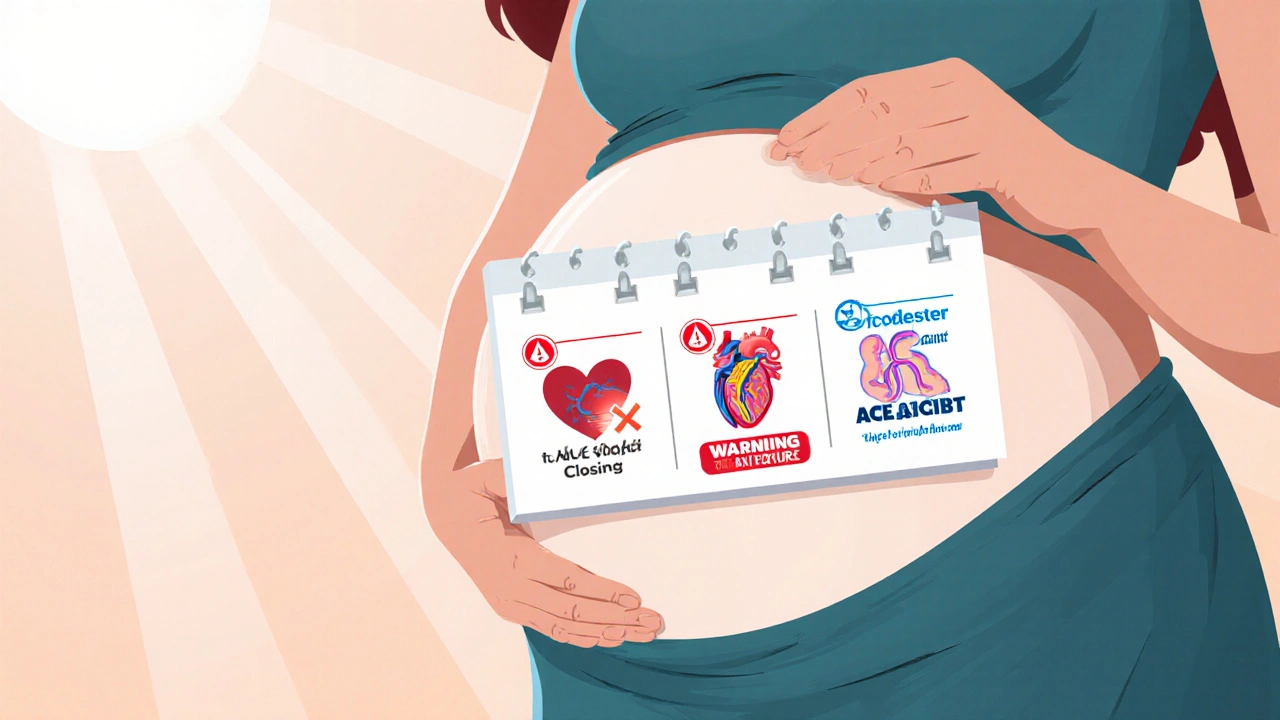
Pregnancy Medication Risk Calculator
Medication Safety Assessment
Check the safety of medications based on your current gestational age and trimester.
When you’re pregnant, taking even a simple painkiller can feel like a high-stakes decision. You’re not just thinking about yourself anymore - you’re thinking about the tiny person growing inside you. And that’s why knowing when to take a medication matters just as much as which one you choose. The truth is, not all medications are risky all the time. Some are safest in the second trimester. Others are fine until week 32, then become dangerous. And some, like isotretinoin, should never be taken at all. Understanding these windows of risk isn’t about scaring you - it’s about giving you real power to protect your baby and yourself.
First Trimester: The Most Critical Window
The first 12 weeks of pregnancy are when your baby’s organs are forming. This is called embryogenesis, and it’s the most sensitive time for medication exposure. If a drug interferes with heart development between days 20 and 40 after fertilization, it can cause a structural defect. If it hits the neural tube between days 18 and 26, it might lead to spina bifida. These aren’t random risks - they’re locked to exact developmental stages. Take isotretinoin (Accutane), the acne medication. If taken between days 21 and 55 after conception, it raises the risk of serious birth defects by 50 times compared to the baseline. That’s why the FDA requires the iPLEDGE program - two negative pregnancy tests before starting, monthly tests while on it, and a full month after stopping. Since this system started, pregnancy rates among women using isotretinoin dropped from nearly 5 per 100 women per year to less than 1. But not everything in the first trimester is dangerous. Acetaminophen (Tylenol) is still the go-to pain reliever, backed by 24 studies involving over 215,000 pregnancies. At standard doses - up to 3,000 mg per day - there’s no clear link to neurodevelopmental issues. But go above that, or use it for more than two weeks straight, and you might tip into risk territory. Some medications only become risky in the first trimester. Ondansetron (Zofran), used for severe nausea, has a small but real increased risk of heart defects - but only if taken before week 10. After that, the risk disappears. That’s why doctors often recommend switching to safer alternatives like doxylamine/pyridoxine (Diclegis) after the first trimester, even if nausea lingers.Second Trimester: Shifting from Structure to Function
By week 13, most major organs are formed. That means the risk of physical birth defects drops sharply. But that doesn’t mean it’s safe to take anything. Now, the concern shifts from structure to function. ACE inhibitors - common blood pressure meds like lisinopril - are fine before week 8. But after that, they can cause serious problems: low amniotic fluid, kidney damage, even skull deformities. The risk peaks between weeks 12 and 20. That’s why doctors switch pregnant patients to labetalol or methyldopa - both have decades of safety data and show no increased risk of major malformations. SSRIs like sertraline (Zoloft) are often continued through the second trimester because the risk of untreated depression can be worse than the medication. Studies of 850,000 pregnancies show sertraline has no significant link to birth defects. But paroxetine (Paxil) is different. Even in the second trimester, it carries a 1.5 to 2 times higher risk of heart defects if taken during the critical window of days 20 to 24 after fertilization. This is where dating matters. Most women track pregnancy by their last period. But developmental stages are measured from fertilization - about two weeks earlier. A woman who thinks she’s 10 weeks pregnant might actually be 8 weeks post-fertilization, putting her right in the danger zone for cardiac defects. That’s why ultrasounds before week 10 are so important - they correct dating errors that lead to 22% of unnecessary pregnancy terminations.Third Trimester: The Physiological Shift
In the final stretch, your baby isn’t building organs - they’re getting ready for life outside. That means the risks change again. Now, the concern is how medications affect the baby’s body systems right before birth. NSAIDs like ibuprofen and naproxen are generally safe until week 20. But after that, they can cause the ductus arteriosus - a vital blood vessel in the fetal heart - to close too early. That happens in 15 to 20% of cases if taken after week 32. Between weeks 20 and 31, they can also reduce amniotic fluid, which can lead to lung underdevelopment and limb positioning issues. SSRIs also flip their risk profile in the third trimester. Sertraline doesn’t cause birth defects, but if taken close to delivery, it can cause neonatal adaptation syndrome in 2 to 3% of babies. Symptoms include jitteriness, feeding trouble, and breathing issues. Paroxetine is worse - up to 30% of babies exposed in the third trimester show signs of withdrawal, including seizures in rare cases. That’s why tapering is now recommended. On November 15, 2023, ACOG and the American Psychiatric Association updated their guidelines: if you’re on an SSRI and want to avoid withdrawal symptoms, reduce your dose by 25% every two weeks starting at 34 weeks. One patient in Phoenix, SarahM, did exactly this - dropping from 100mg to 50mg over six weeks - and avoided the neonatal withdrawal her first child experienced when she stopped cold turkey at 36 weeks.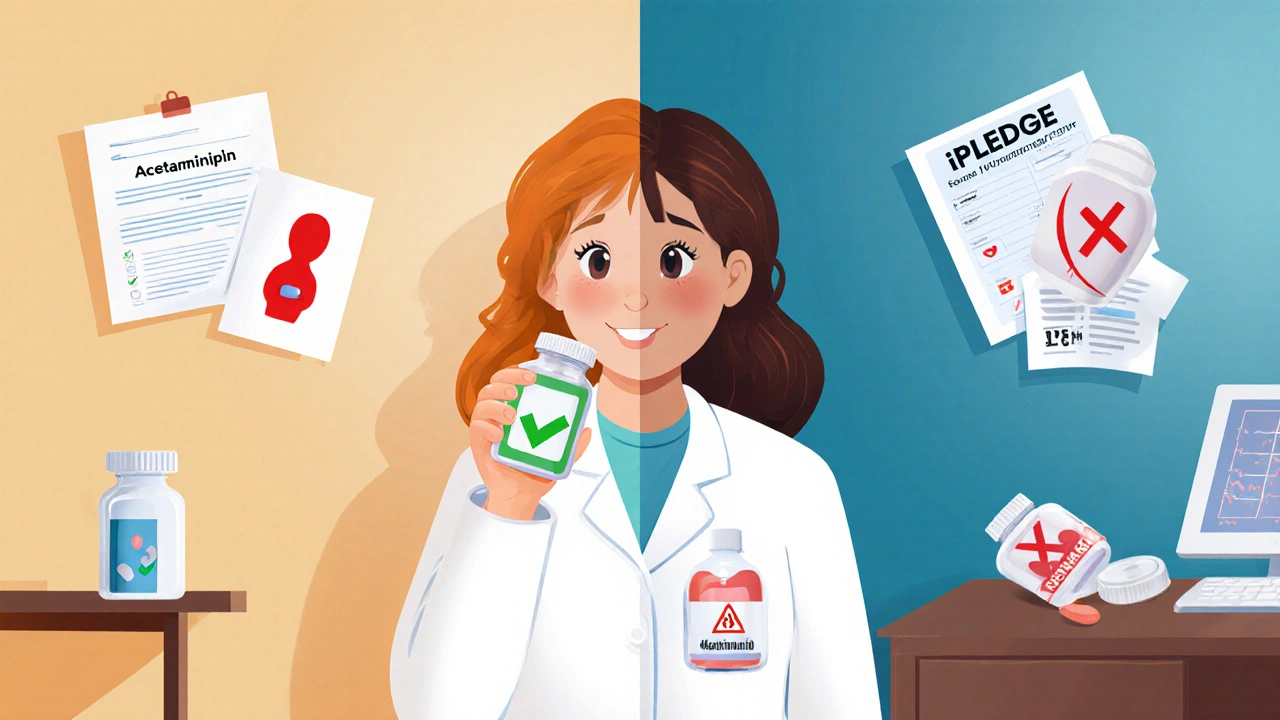
What About Over-the-Counter and Supplements?
Many people assume OTC meds are safe. They’re not always. Cold and allergy meds often contain antihistamines. Loratadine (Claritin) is Category B - meaning no proven risk in human studies. But many providers still tell patients to avoid it in the first trimester, based on fear, not data. A Reddit community moderator with 15,000 members found that 45% of users were told to avoid all allergy meds in early pregnancy, even though evidence says loratadine and cetirizine are fine. Vitamins are another gray area. Folic acid? Essential - reduces neural tube defects by up to 70%. But vitamin A in high doses (over 10,000 IU/day) can be as dangerous as isotretinoin. Most prenatal vitamins contain safe levels, but some women take extra - not realizing they’re risking harm.How to Navigate This Without Panic
You don’t need to stop every medication the moment you find out you’re pregnant. But you do need to be proactive. Start with a medication review with your OB or midwife. Bring your list - prescriptions, supplements, OTC drugs, even herbal teas. Don’t assume anything is safe. Even ginger, often recommended for nausea, can interact with blood thinners. Use trusted resources. The CDC’s Treating for Two tool helps you sort meds by trimester. MotherToBaby offers free, confidential consultations with specialists - they handle 25,000 calls a year and can convert your LMP date to fertilization age, so you know exactly when you were exposed. And if your provider says, “Just stop it,” ask why. What’s the risk? What’s the alternative? If they can’t answer, ask for a referral to a maternal-fetal medicine specialist. You have a right to clear, evidence-based advice.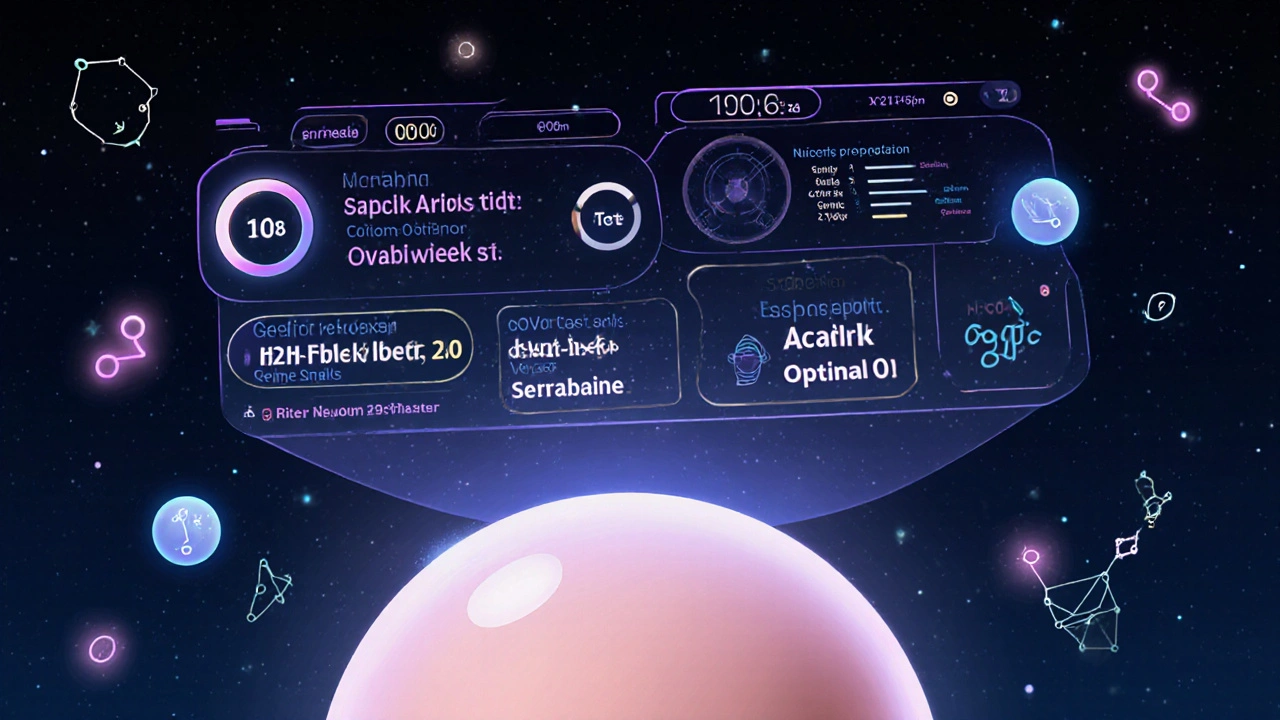
What’s Changing Now - And What’s Coming
The FDA now requires pregnancy exposure registries for 93% of new drugs - up from less than 60% a decade ago. That means more data is being collected. But here’s the catch: only 27% of drug labels include quantitative risk estimates by trimester. That’s why tools like TERIS and Micromedex exist - they compile real-world data from thousands of pregnancies. In 2023, the NIH funded a $4.7 million project to build a trimester-specific risk calculator that factors in your genetics, metabolism, and exact gestational age. By 2025, it could be ready for testing. In five years, doctors may use your polygenic risk score to say, “This medication is safe for you, but risky for others with your genetic profile.” The goal isn’t to eliminate all medication use in pregnancy. It’s to use the right drug, at the right time, at the right dose. Because sometimes, not treating high blood pressure or depression is far riskier than the medication itself.What You Can Do Today
- Make a list of every medication, supplement, and herb you take - even aspirin or melatonin.
- Ask your provider: “Is this safe for my baby? And if not, what’s the alternative?”
- Don’t rely on Google or Reddit. Use MotherToBaby.org or the CDC’s Treating for Two tool.
- If you’re on a medication that’s risky in the first trimester, talk to your doctor before trying to conceive.
- Get an early ultrasound to confirm dating - especially if you’re unsure of your last period.
Medication safety in pregnancy isn’t about avoiding all drugs. It’s about timing. It’s about knowing which window you’re in - and making informed choices based on real science, not fear.
Is it safe to take Tylenol during pregnancy?
Yes, acetaminophen (Tylenol) is considered the safest pain reliever during pregnancy. Studies involving over 215,000 pregnancies show no significant link to birth defects or developmental issues when used at standard doses (up to 3,000 mg per day). Avoid prolonged use (more than two weeks) or doses above 3,500 mg daily, as high doses may carry unknown risks.
Can I continue my antidepressant during pregnancy?
Many antidepressants, especially sertraline (Zoloft), are considered low-risk during pregnancy. The risk of untreated depression often outweighs the medication risk. However, paroxetine (Paxil) should be avoided in early pregnancy due to heart defect risks. If you’re in the third trimester, your doctor may recommend tapering slowly to reduce neonatal withdrawal symptoms. Never stop abruptly without medical guidance.
Are NSAIDs like ibuprofen dangerous during pregnancy?
NSAIDs are generally safe before week 20. After that, they can cause premature closure of the ductus arteriosus (a fetal blood vessel) and reduce amniotic fluid levels. The risk is highest after week 32. If you need pain relief after week 20, acetaminophen is the preferred option. Always check with your provider before using any NSAID during pregnancy.
What should I do if I took a risky medication before knowing I was pregnant?
Don’t panic. Many medications have an "all-or-nothing" effect in the first two weeks after fertilization - meaning if they cause harm, the pregnancy won’t continue; if it continues, the baby is likely unaffected. If you took a risky drug after that, contact MotherToBaby or your OB immediately. They’ll assess your exposure based on exact timing, not just your last period. Most exposures don’t lead to birth defects, and early evaluation can prevent unnecessary stress or decisions.
How do I know if my pregnancy dating is accurate?
First-trimester ultrasounds are the most accurate way to date a pregnancy. If your due date based on your last period differs by more than 5 days from your ultrasound, the ultrasound date is used. This is critical because developmental risks are measured from fertilization - not your last period. Misdating is a leading cause of unnecessary pregnancy terminations after suspected medication exposure.
Is it safe to take allergy meds like Claritin during pregnancy?
Yes, loratadine (Claritin) and cetirizine (Zyrtec) are considered safe throughout pregnancy. Studies show no increased risk of birth defects. Many providers still advise against them out of caution, but evidence supports their use. If you have seasonal allergies, these are better options than decongestants like pseudoephedrine, which can reduce blood flow to the placenta.

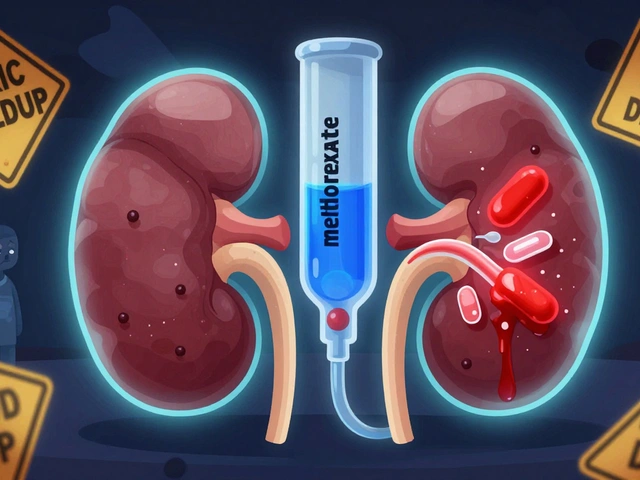



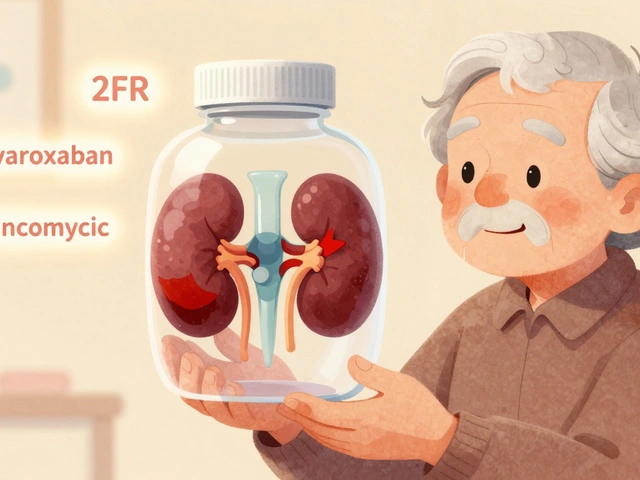
10 Comments
tylenol is fine just dont go over 3k a day and dont use it for 2 weeks straight. stop overthinking it. i took it all 3 trimesters and my kid is 12 and plays lacrosse. no issues. stop listening to fearmongers.
YOU PEOPLE ARE STILL USING IBUPROFEN AFTER WEEK 20?? WHAT IS THIS, 2008?? NSAIDs after 20 weeks are fetal suicide pills. I had a friend who took naproxen at 34 weeks and her baby had to be rushed to NICU for ductus arteriosus closure. This isn't "maybe risky" - it's a medical emergency waiting to happen. Stop being lazy and switch to acetaminophen. Your baby's heart isn't a gamble.
It is imperative to note that the FDA's iPLEDGE program, while administratively cumbersome, has demonstrably reduced isotretinoin-related teratogenicity by over 80%. The statistical significance of this intervention cannot be overstated. Furthermore, the correlation between maternal SSRI use and neonatal adaptation syndrome remains statistically significant (p < 0.01) in longitudinal cohort studies. To dismiss these findings as anecdotal is not merely irresponsible - it is a violation of the Hippocratic Oath.
Indeed, the temporal nature of fetal development reveals a profound truth: life is not a linear progression, but a series of delicate thresholds. To administer a drug without knowing whether one is in the window of organogenesis or physiological maturation is to play roulette with the soul. We must not reduce medicine to a checklist - we must become its custodians. The mother's body is not a vessel; it is a temple of becoming. And in this temple, even the smallest misstep echoes through generations.
bro i took zofran at 8wks and my kid is 3 and runs like a cheetah. dont panic. the risk is tiny. but yeah switch to diclegis after 10wks. also dont trust your lmp - my ultrasound said i was 2wks ahead and that changed everything. mothertobaby saved my life. call them. they dont judge.
Dear friend, your courage in seeking evidence-based guidance is commendable. I urge you to consult with a maternal-fetal medicine specialist before making any pharmacological adjustments. The data is clear: sertraline is the gold standard for SSRI use in pregnancy, and tapering at 34 weeks significantly reduces neonatal withdrawal. You are not alone in this journey. Your child's well-being is a sacred trust - honor it with wisdom, not fear.
THEY'RE HIDING THE TRUTH. 🚨 WHY IS THE FDA STILL APPROVING SSRIs FOR PREGNANCY WHEN THE PHARMA COMPANIES KNOW ABOUT THE NEONATAL WITHDRAWAL RISK?? 🤔 THEY'RE PROFITING OFF YOUR FEAR AND YOUR BABY'S SUFFERING. 🧠💔 I SAW A VIDEO OF A BABY HAVING SEIZURES FROM PAROXETINE WITHDRAWAL - IT WASN'T A "SYNDROME," IT WAS A CRISIS. 📉 #PharmaLies #TreatForTwoIsABlackout
Let’s be real - most of this "evidence" is based on observational studies with confounding variables. The 215k-pregnancy acetaminophen study? Didn’t control for maternal BMI, smoking, or concurrent polypharmacy. And who the hell is SarahM from Phoenix? Is she even real? This post reads like a pharmaceutical whitepaper dressed up as Reddit wisdom. The real risk? Trusting a blog that cites "Reddit moderators" as evidence. 🤡
Okay I just had to say this - I took sertraline all through pregnancy, tapered down from 150mg to 75mg starting at 34 weeks, and my baby was perfect. No jitteriness, no feeding issues, just a sleepy, sweet newborn who slept through the night at 6 weeks. I cried when my OB said "it’s safe" because I’d been terrified for 9 months. Please, if you’re on an SSRI - you’re not broken for needing it. You’re a warrior for managing your mental health while growing a human. And yes, MotherToBaby is a lifesaver. I called them at 8 weeks after accidentally taking ibuprofen. They walked me through it like I wasn’t a panic mess. You’re doing better than you think. 💕
Start your meds review today. Not tomorrow. Not after your next appointment. TODAY. Write down every pill, every tea, every supplement. Bring it to your provider. Ask: "Is this safe?" If they hesitate - get a second opinion. You deserve clarity. You deserve safety. And your baby deserves a mom who fights for the truth. You’ve got this. 💪